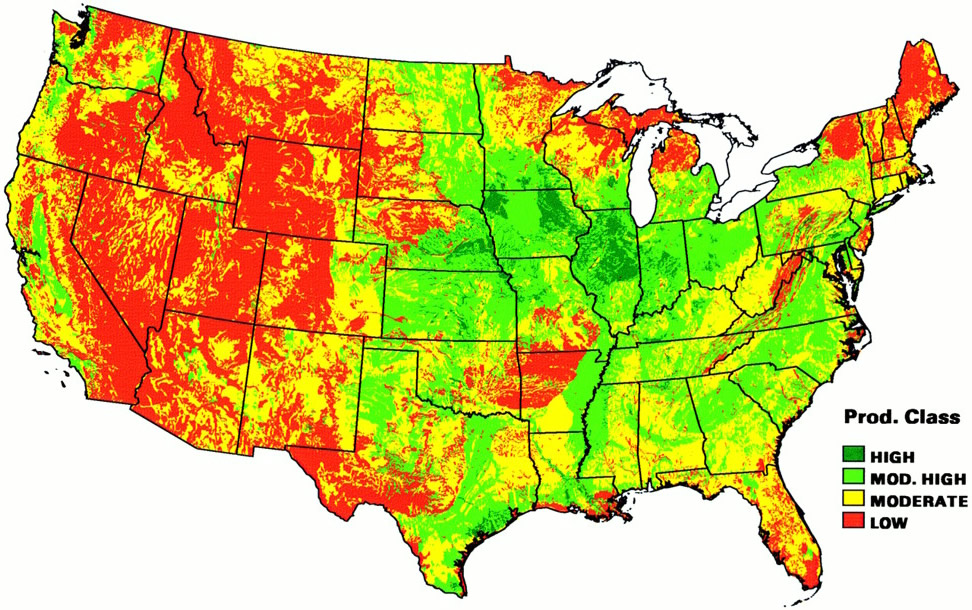WEEK 9 |
Overview
A. Land use - sprawl and urbanization
B. Multiple perspectives can be combined into a framework that sets you up to take action.
C.
Innovation may be required to solve environmental problems
|
Assessment feedback and quiz 2 discussion
|
1. Lecture notes |
A. Land use and misuse. |
A1. Land use
review figure for global land use from last lecture
image from http://foodfreedom.wordpress.com/2009/11/22/extinctions-over-population-and-the-profit-paradigm/

Interested in finer scale description and shifts in land use
Urban encroachment on arable lands
Canada: cities are expanding onto prime agricultural land -
- expanding by 7400 km^2 in 30 years upto to 2001
- 7% of best ag land and 4% of total ag land
USA: historically the location of cities are in fertile land
- urban land only 3% of total
- 6% of the best class of highly productive soils are under cities



Biomes and Ecoregions - consideration of natural capital
background info
key info (and see the on-line activity section below)
|
A2. Urbanization
Cities are important
centers of education, new ideas and exchange of those
some comparison between structure of cities and brain
emergent structures
engines of innovation
spread of innovation, usually starts at cities Hagerstrand, Torsten.1967. Innovation Diffusion as a spatial process
social structures that promote change
"elites" in bureacratic positions of power
PSU played a role in this city (needle exchange - Hugo Maynard, other examples)
Portland has engagement (from watershed councils)
Putnam, R.D. 1993.
Making Democracy Work: Traditions in modern Italy.Putnam - Bowling AlonePutnam & Feldstein 2003 Better Together" Restoring the American Community
with a chapter on Portland - "Portland: A positive epidemic of civic engagement"
trust -> engagement -> democracy
urban growth
(positive feedbacks for big cities - jobs, crime in rural areas, closely
related to the poverty cycle)
megacities
proportion of population in large cities
50% now on only 2% of land area
(developed, developing)
quality of city life
improvements
densitiy - pollution
Processses in urban areas
urban areas as processors of material
good aspects - recycling and lower use
bad aspects - not self sustaining, density/pollution, poverty
urban poor -
transportation systems
mass vs. individual
automobiles and their effect
taxes and fees
multiple transportation options (why it's good to live in Portland)
degree and rate of urbanization
Latin America and Caribbean for example
into what type of land?
- Nicaragua - dry tropical forest
- WWF - interactive map of ecoregions
World's Largest Cities
|
A3. Sprawl
Multiple factors provided stimulus for sprawl
- ample land
- home loans
- low-cost gas
- mortgage write-off on taxes
- zoning - separation of business and residential
- numerous governments (city, county, etc)
Undesirable aspects of sprawl
How can we stem or reverse sprawl in the United States?
not just the removal of a factor
restoration
|
B. Multiple Perspectives |
B1. The framework
- Chapter 12
- the four steps
- similarity between using these rich narratives and the worldviews
|
B2. Example
water availability and how to provide clean water to rural poor
- describe what features are prominent and easy to deal with
- systems approach
- risk & uncertainty
- accounting
- risk & uncertainty
- worldviews
- local expert input
- overlap
- adaptive management plan
- management actions are treated as experiments
- dual goals are
- both required
- to make progress toward solving problem
- reduce uncertainty for future work
|
| |
2. In class assessment and feedback
question: give example quiz questions
comment: feedback in class on good and "un-gradeable" answers.
|
3. Reading in "Multiple Perspectives" text
Chapter 12 - Multiple Perspectives Framework
to be prepared for next week
Chapter 13 outline on Innovation
Combinatorial Innovation
|
4. Reading from Wikipedia or Encyclopedia of Earth
Land as a resource:
Innovation
|
5. On-line activities:
Videos:
paving farmland
Ted Talk - Eric Burlow talks about how getting the big picture (using networks) can actually help address complex problems
In a companion blog, Erick Burlow addresses some of the interesting points including a comparison of network vs. systems approaches. Of particular interest in this is how positive feedback loops can help solve these problems.
Exercise:
Although we usually associate land use with the buildable land or farming, human population pressures such as urbanization and agriculture have major impacts on the watersheds.
Compare several different areas in the world, starting with a few that you are familiar with (such as Columbia Unglaciated - Columbia River Basin and Lakes Region i.e. central Oregon). Examine the threats to freshwater ecology in these areas.
Pick another couple regions that represent low vs high water availability, tropics vs. temperate, urbanized vs. rural. Do these comparisons make sense? If not, what surprised you?
freshwater ecosystems of the world
|
6. Learning objectives:
week 9 learning objectives
|
7. Link to the on-line assignment:
go to D2L
|
8. Quiz feedback
Quiz 9 -
1. List several methods of farming that are used at Polyface Farm that might seem unusual or innovative. Describe how some of these work together to provide this farming approach with very high efficiency.
the bolded part is the key to this question
2. look up the answer in the freshwater impact site (FEOW) assigned in the online section
3.
need to analyze this in terms of I=PAT, not just state what I=PAT means
4. List at least four factors that have contributed to Sprawl. Describe how these factors have interacted to result in worse sprawl, i.e. synergistic effects. What does it mean for reversing sprawl, that these factors worked together to cause it?
what is the problem with undoing the results of a process that had many interwoven processes
|
| |


![]()